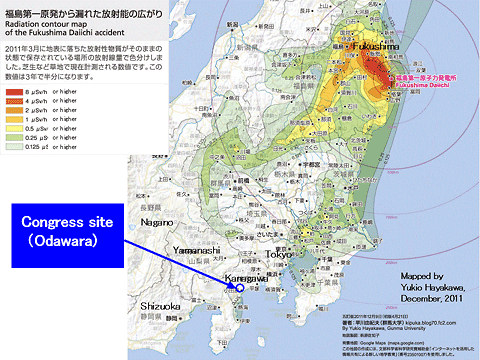The radioactivity level in Kanagawa prefecture (Congress site) is as low as the level before the earthquake
The present level of environmental radioactivity in Kanagawa prefecture (monitored at Chigasaki city) is 0.045 microSv/hour (17th March 2012). It ranges from 0.03 to 0.08 (average, 0.04) at 47 points in Odawara city (6-13 March 2012).
The maximum and minimum values observed before the earthquake were 0.035-0.069 at Chigasaki city.
Source of the data of Odawara:
http://www.city.odawara.kanagawa.jp/...pdf
*Sv = Sievert (microSv = Sv/1,000,000), the unit of dose equivalent radiation to quantitatively evaluate the biological effects of ionizing radiation.
Why is the radiation level in Kanagawa prefecture as low as before?
Because radioactive substances released from the Fukushima-Daiichi nuclear power plant fell down mostly in and around Fukushima prefecture, being carried by the wind and the rain at those dates and times of the explosion events (*Hayakawa 2011). Therefore, the area west to Tokyo escaped from the contamination with radioactive substances except a few 'hot spots'.
Please confirm this on the next picture (Radiation contour map).
This map is based on a compilation of available radiation dose rate data from various sources and has been referenced by committees of the national assembly and published in various media sources.
Food Safety in Japan after the Nuclear Disaster
Food specialist Martin J. Frid examined the question of risk in light of international standards on radiation.
The March 11, 2011 earthquake, tsunami and nuclear disaster worry many people about Japan's food safety.
The first test results after March 11, 2011 showed very high levels of radioactive substances on crops, spinach and bamboo shoots that were growing in certain areas around the nuclear reactors. Such foods were not put on sale, and the government set a provisional regulation limit of 500 Bq/kg and mandated that food that had levels below the limits could be sold.
For the entire country, over 120,000 food products have been tested, and the total number of cases that exceeded the limit was 1,162 or just below 1%. New, much stricter limits of 100 Bq/kg were announced in December, and will be implemented from April 1, 2012.
The food contaminated by airborne particles emitted after the hydrogen explosions in March 2011 fall into four categories:
- the vegetables (e.g., spinach, bamboo shoots and mushrooms) that were growing outdoors in Fukushima prepecture and its adjacent areas;
- the beef and meat products and milk, which were contaminated due to cattle being fed contaminated.hay and straw;
- the tea that the airborne particles led to the contamination; and
- fish caught either in inland waters of Fukushima prefecture or in the Pacific Ocean along the Tohoku coast.
This suggests that it is not likely that food grown from now on will be highly contaminated, or at least the number of such cases will be very limited. One year after the disaster, the number of samples that are found to be highly contaminated has decreased, in most cases dramatically.
Safety standards or levels differ from country to country for a number of reasons, including estimates of intake and food habits. The Table-1 shows Japan's levels compared to levels in the US, EU, and Codex: The data show that from the start in the immediate aftermath of 3.11, Japan applied more rigorous standards than either the US, European Union or Codex, and these standards are to be made even more rigorous in April 2012.
Table-1. Japanese and overseas limits on radioactive cesium in food.
| Unit: Bq/Kg |
Drinking Water |
Milk |
General foodstuffs |
Food items for babies |
| Japan (New limits from April 1, 2012) |
10 |
50 |
100 (Including dairy products) |
50 |
| Japan (Provisional limits from March, 2011) |
200 |
200 (Including dairy products) |
500 |
200 |
| United States |
1,200 |
1,200 |
1,200 |
1,200 |
| European Union |
1,000 |
1,000 |
1,250 |
400 |
| Codex |
1,000 |
1,000 |
1,000 |
1,000 |
It is important that farmers and food producers with government support find ways to ensure that food products with high levels of radiation do not reach consumers. Rice, for example, cannot be grown in certain areas near the Fukushima Daiichi Nuclear Plant.
For all the losses imposed by the 3.11 disaster, an extraordinary fact is that Japan enjoys high levels of food safety, and foods from Japan can continue to be appreciated at home and abroad, after continued careful testing.
*Martin J. Frid, born in Sweden, works for Consumers Union of Japan. He is the author of the food guide book Nippon no Shoku no Anzen 555 (Kodansha) published in 2009. He has participated in food safety meetings on the local, national, and international levels, including as an expert at FAO/WHO Codex Alimentarius Commission meetings. He currently resides in Saitama, Japan.

